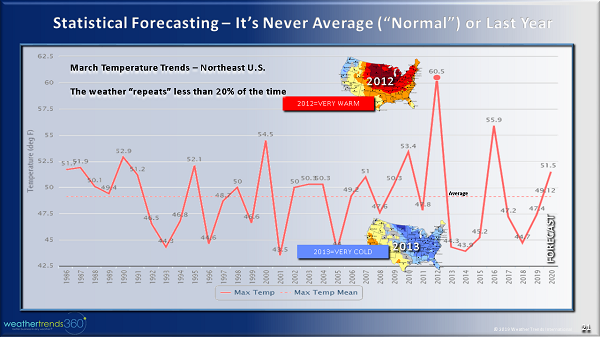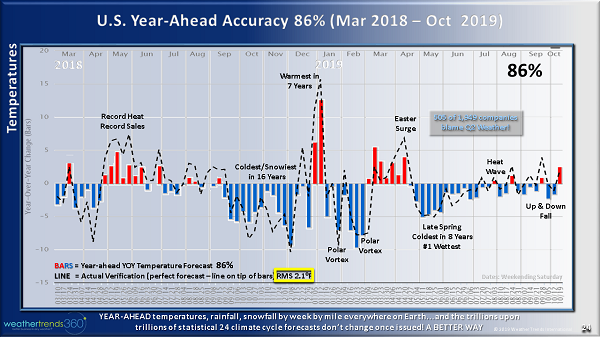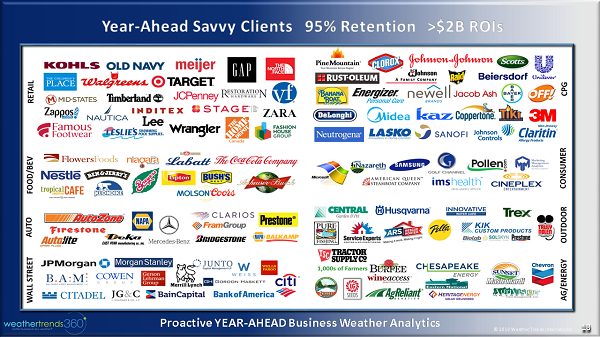How to Forecast Retail Sales Using Weather
Business
The 2019 holiday season saw major retailers like Target slash Q4 growth projections because sales failed to match expectations.
Setting (and meeting) realistic sales forecasts is critical to keeping investors and boardrooms happy. Yet, so many businesses struggle to do this in an accurate way. This is bad because if they can't, they won't know how fast their business is growing.
Now, while forecasting growth is challenging, calculating a projected growth rate is actually very easy. It's a simple equation:
Projected Growth Rate = (Next Year's Sales - Last Year's Sales)/Last Year's Sales
So, how do you figure out what next year's sales will be?
In this post, we're going to focus on two methods: Traditional methods, which use sales data, and newer methods, which use weather intelligence.
Forecasting Using Sales Data
A common approach for predicting next year's sales is planning off last year. But planning off of last year is only correct about 20% of the time. There's no reason to presume the conditions that drove last year's sales will be in play the following year.

Because of this, experts recommend projecting revenue based on internal factors, such as product price points, number of marketing channels and number of salespeople on staff. These factors are quantifiable and within the company's control.
But what about external factors you can't control?
The reason most models and businesses don't account for external factors, like market demand, is because traditional wisdom holds that there's no way to predict this.
But for businesses to accurately project sales growth, they need to account for the behavior of the markets they play in. And to understand the market, you'll need data and insight into the variables driving the market. Because of this, many businesses are turning to a variable they can predict: the weather.
Forecasting Using Weather Intelligence
I know what you're thinking: "But no one can predict the weather!"
You're half right. Physics-based, meteorological forecasting can't accurately predict the weather beyond 7-10 days. Not that it matters much because this is nowhere near enough time to project annual sales.
But a statistics-based forecasting model makes it possible to predict the weather up to a year out with a great degree of accuracy.

This method integrates historical weather data with historical sales data. Using it, retailers can predict how weather will impact business in the year ahead. And there are a lot of ways they benefit from it.
But the biggest is that it helps them create more accurate sales forecasts.
Retailers need time to plan. It takes 3-6 months to order and deliver new inventory. If you have accurate, long-range weather forecasting in place, you can spot opportunities early enough to get what you need where you need it.
For example, if you know the weather is going to increase sales for umbrellas by 5%, you can make sure the right amount of inventory is stocked in the right locations. This enables you to make more accurate forecasts and clearer business decisions. All one year ahead. We know because the retailers we work with have increased their forecasting accuracy to above 80%.

Weather intelligence makes sales forecasting easier by providing accurate and actionable insights to ground the forecast in. With tangible data on external market factors, you don't have to worry about accounting for the uncertain. You can forecast your retail sales based on internal and external factors.
The Bottom Line
If you're going to forecast next year's sales, you'll need insight into external factors that relate to tangible actions you can control. Statistics-based, long-range weather forecasting helps you predict and maximize next year's sales while setting realistic expectations with Wall Street and the board.
Setting (and meeting) realistic sales forecasts is critical to keeping investors and boardrooms happy. Yet, so many businesses struggle to do this in an accurate way. This is bad because if they can't, they won't know how fast their business is growing.
Now, while forecasting growth is challenging, calculating a projected growth rate is actually very easy. It's a simple equation:
Projected Growth Rate = (Next Year's Sales - Last Year's Sales)/Last Year's Sales
So, how do you figure out what next year's sales will be?
In this post, we're going to focus on two methods: Traditional methods, which use sales data, and newer methods, which use weather intelligence.
Forecasting Using Sales Data
A common approach for predicting next year's sales is planning off last year. But planning off of last year is only correct about 20% of the time. There's no reason to presume the conditions that drove last year's sales will be in play the following year.

Because of this, experts recommend projecting revenue based on internal factors, such as product price points, number of marketing channels and number of salespeople on staff. These factors are quantifiable and within the company's control.
But what about external factors you can't control?
The reason most models and businesses don't account for external factors, like market demand, is because traditional wisdom holds that there's no way to predict this.
But for businesses to accurately project sales growth, they need to account for the behavior of the markets they play in. And to understand the market, you'll need data and insight into the variables driving the market. Because of this, many businesses are turning to a variable they can predict: the weather.
Forecasting Using Weather Intelligence
I know what you're thinking: "But no one can predict the weather!"
You're half right. Physics-based, meteorological forecasting can't accurately predict the weather beyond 7-10 days. Not that it matters much because this is nowhere near enough time to project annual sales.
But a statistics-based forecasting model makes it possible to predict the weather up to a year out with a great degree of accuracy.

This method integrates historical weather data with historical sales data. Using it, retailers can predict how weather will impact business in the year ahead. And there are a lot of ways they benefit from it.
But the biggest is that it helps them create more accurate sales forecasts.
Retailers need time to plan. It takes 3-6 months to order and deliver new inventory. If you have accurate, long-range weather forecasting in place, you can spot opportunities early enough to get what you need where you need it.
For example, if you know the weather is going to increase sales for umbrellas by 5%, you can make sure the right amount of inventory is stocked in the right locations. This enables you to make more accurate forecasts and clearer business decisions. All one year ahead. We know because the retailers we work with have increased their forecasting accuracy to above 80%.

Weather intelligence makes sales forecasting easier by providing accurate and actionable insights to ground the forecast in. With tangible data on external market factors, you don't have to worry about accounting for the uncertain. You can forecast your retail sales based on internal and external factors.
The Bottom Line
If you're going to forecast next year's sales, you'll need insight into external factors that relate to tangible actions you can control. Statistics-based, long-range weather forecasting helps you predict and maximize next year's sales while setting realistic expectations with Wall Street and the board.